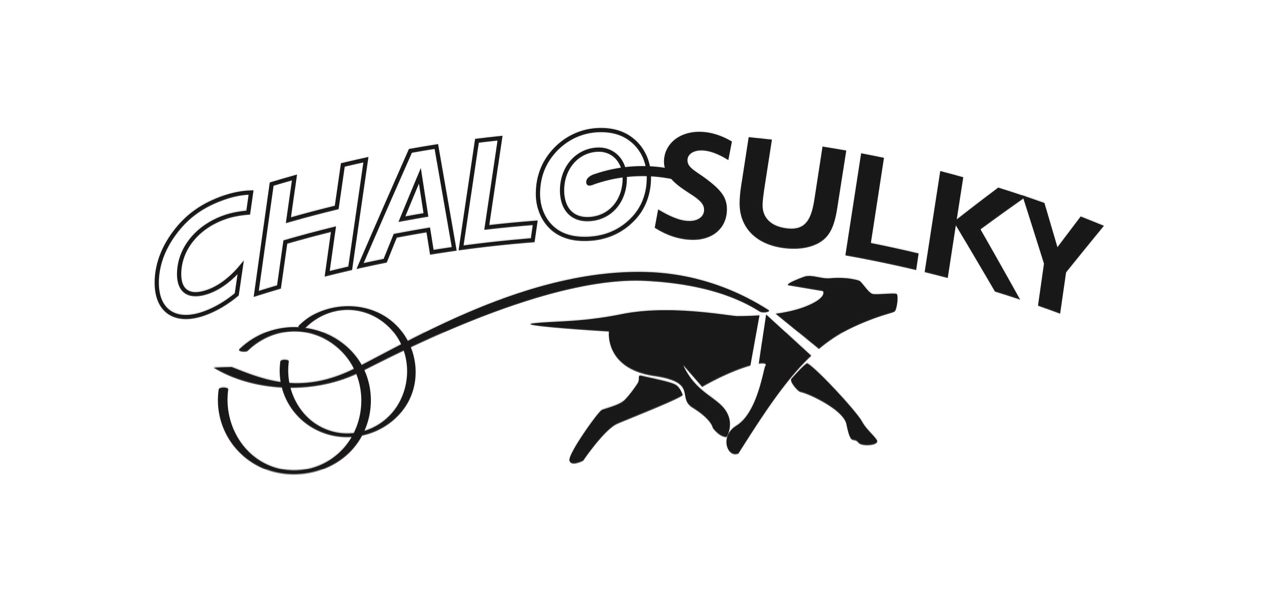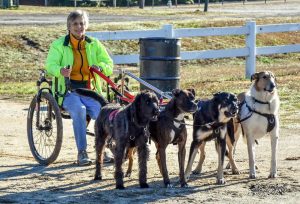Dogs that pull love their work.
Dogs that pull respect their owners and are easy to live with.
Workshops – Group and Individual
Chalo Sulky sometimes offers group workshops. We offer them in December, January and February because the weather is cool enough here in middle Georgia to work with the dogs all day. We do not have workshops scheduled for 2023.
Daphne Lewis also offers individual workshops year around. Let your dogs chase Daphne and her team around the Bamboo Farm. They discover that pulling a sulky is fun and that they can do it.
See training videos at bottom of page.
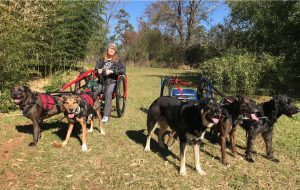
BASIC SKILLS
Sulky dogs need these skills.
- Stand and stay when commanded (no twisting around).
- Accept something dragging behind them.
- Face away from the drag or sulky at all times (“Line Out”)
- Pull hard enough to start the sulky and keep it going.
- Pull and stop on command.
- Change gaits on command.
- Ignore distractions and continue working (“On by”).
- Turn right and left on command (“Gee and Haw”).
- Respond to voice and/or reins.
- Wait in place.
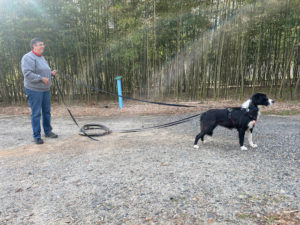
The dog must work in front of you and face away from you when hitched to a sulky, wagon, or scooter.
As you work these training exercises on-leash, as quickly as is practical, discontinue walking beside the dog. Walk behind the dog. With practice, you can snap a flexi-leash, long-line or reins to the driving-collar and walk behind the dog and the drag if you are using one.
If you have more than one dog, ground-train the dogs individually. Once the dogs are working well individually, connect their collars with a neckline and train them together.
GROUND TRAINING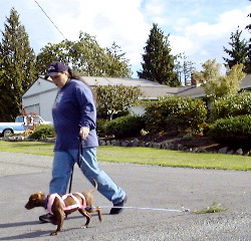
Buy or make a harness. For ground training, the harness can be a simple one from the pet store. Fit it to the dog. The harness means “We are working now”. Don’t let him play while wearing it. Take the harness off immediately at the end of each training session. Take it off after unsnapping the drag.
Often the biggest first problem in training the dog is “How do I get him to move away from me?” Watch how Mary Dick trained her giant schnauzers in this video. https://youtu.be/rMmoo7PIX0o
Make a drag. I use bicycle tires zip-tied together. (Cut through one side of the tire. That way if you hit a root, the tire will not catch on the root and stop the dog suddenly.) You can use anything that will drag behind the dog so long as it will not roll or bounce into him. You do not want to scare the dog! People use chains, burlap bags with sand in them or bundles of brush. The red puppy in the photo is pulling a branch of a Douglas Fir. Her harness was sewn on a home machine by her owner.
Leash the dog. Use a light, easy-to-pull drag and go for the first walk. The dog will startle at having something dragging behind him. He may jump around and act up. Tell him “Pull” or “Walk on” and calmly take a walk with him. A sidewalk is ideal because it shows what direction to go in. Walk quickly and happily with him. Alternate the commands “Pull” and “Wait”. Vary the amount of time that you “Wait”. You want “Pull” to be a happy relief to standing and waiting. This exercise of Pull/Wait causes the dog to pay attention to you and to what you are doing. It lays the foundation for obedience when pulling.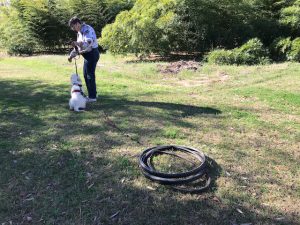
Some people use treats. I have not done this, but at workshops, I have seen people using the treats to motivate the dog to pull. If treats help the dog to enjoy the training, use them. More often, though, the kind of dog being trained is full of energy and does not need treats to go. He needs to learn to go with control.
Ground train the dog on various surfaces. The drag will make different noises depending on the surface. Start your pulling on a quiet surface like a lawn. New dogs may be fine pulling over quiet lawns. Then they may startle at the noise of sidewalks. Save the noisy gravel for later after the initial fear of something dragging behind him is over and the pleasure of going dominates.
Once the dog is at ease pulling the drag, and Pulls and Waits as you command, add more weight to the drag. For example, use three bicycle tires instead of one. At first you want him to accept something behind him and not be afraid. Accomplish that with a light drag: one bicycle tire. Next you want him to learn to lean into the harness and pull. Accomplish that with a heavier drag: three or more bicycle tires. I do not use heavy tires for initial training because I want the exercise to be fun.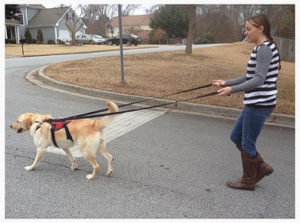
If your dog is habitually running the fenceline barking at dogs or indulging in similar dangerous behaviors, use a prong collar while doing the ground training. When he starts on his chase instinct, tell him “On By!!”, give a quick correction with the prong collar and run past the distraction. “On By” means “Go On By the distraction”. Each time the dog starts his charge-the-fence (or chase the squirrel) mode, say “On By” and run him past the distraction. Do this preventive action before he is fully engaged in the run-the-fence mode. Make running past the distraction FUN.
“On By” also means to go on by the turn in the trail that he expects to take or to go on by your car. During ground training after passing a distraction, you can give huge praise. “Good On By! Good Dog!” Give treats if that is how you train. Mushers use “Gee” for “Right” and “Haw” for “Left”. You can use whichever words you can remember when driving. Many people use “Right” and “Left”.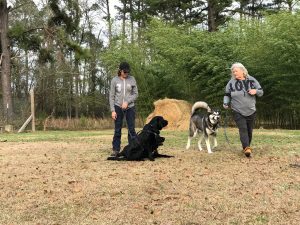
“On By” is more effective than “NO! DON’T DO THAT!” because it gives alternate behavior. Train the proper behavior; use “On By”.
Remember: when the dog is wearing his Harness, he is working. Don’t let him go off the trail to chase a critter. Don’t let him sniff. Don’t let him Go Say Hi to loose or on-leash dogs. He must pass on by them. Ground training allows you to correct the behavior and teach an alternate good behavior. You can’t correct the behavior as well while sitting in a sulky. People will want their dog to say Hi to your working dog. Tell them that your dog is working. He is in training.
Mushers use “Gee” for “Right” and “Haw” for “Left”. You can use whichever words you can remember when driving. Many people use “right” and “left”. Use leash walks to teach: “Right”/”Left” (Gee/Haw); “Walk”/ “Trot”/ “Hike! Hike!”; and “Wait”/”Pull”. A further set of commands is “Over right” and “Over Gee”. Dogs need to learn to stay on the right hand side of a public trail. Say “Over right” and move to the right side.
My dogs stay to the right on roads and paved trails. I reinforce this habit with the “Over Gee” command meaning “Move over to the Gee side”. When you are on a trail with pedestrians, you will catch up with them. Let the people know you are coming. Tell your dogs “Over Left/Haw” so that you can pass the pedestrians politely on their left. Passing correctly is one of the more advanced skills of a driving dog.
Do let people know that you are coming up behind them. Don’t scare them. Be courteous. You are an ambassodor for this sport.
At our workshops we use mentor dogs when appropriate. Photo with cars shows malamute working with novice guardian dog on second day of work shop. Second photo shows class working their dogs with reins and learning to work up front. Gina Hunter and her trained dogs lead the group in a half mile walk.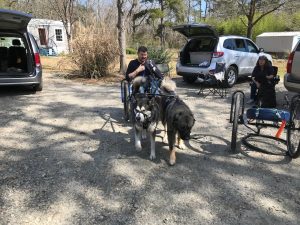
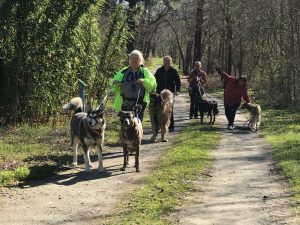
COMMANDS
Right/Left (Gee/Haw)/Straight
Over Right/Over Left (Over Gee/Over Haw)
Gee Come/Haw Come (Reverse direction by turning 189°to right)
On By (Go on by the distraction)
Line Out (face away from the sulky; hold the tug-line out tight)
Easy (to slow down)/ Hike,Hike (to speed up)
Walk On, Let’s Go, or All right, or OK (eager dogs don’t need much encouragement to go)
Pull (can be used to start; and/or to tell them to pull harder as in going up a hill)
Water! (tells my dogs to get into the puddle, lake, stream to cool off)
Find the Car/ Go to the car (They know where it is!)
Walk, Trot, Hike!Hike! (for gait changes)
Wait (Whoa), sit, down, stay, stand
Back up
UP FRONT AND PULL
In the previous exercises, the dog learned to pull the drag. He learned the commands.
To pull a sulky, the dog must work in front of the sulky while facing away from you. Perhaps your dog naturally pulls in front of you. He will be easier to train than a dog that has been carefully trained to walk beside you. It helps to have a friend walk with a leash beside your dog while you walk behind the drag. You give the orders. Your friend can guide the dog.
Every time that you are ground training, encourage the dog to work in front of you. Gradually it becomes a habit.
COLLAR AND HARNESS TELL THE DOG WHAT TO DO
Snap the leash to the collar and the dog walks beside you.
Snap the tugline to the harness and the dog works in front of you.
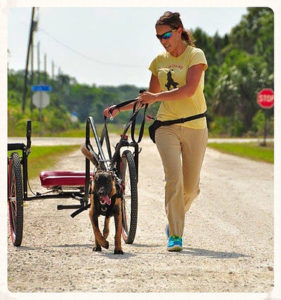 TRAIN THE SULKY
TRAIN THE SULKY
When you have a problem while driving the sulky, it is often useful to go back to ground training because on the ground, you can enforce the command.
Now that you are ready to train the dog to pull a sulky, you must have a sulky harness and reins. The harness must be built to fit the particular sulky that you own.
Dogs have an easier time learning to pull a sulky on a trail instead of a parking lot. A dog will naturally follow a trail. Find a trail that is relatively free of distractions such as other dogs. Find one that beckons and arouses curiosity as to what lies ahead.
Before you hitch the sulky to the dog, fasten enough weight to the seat (or luggage rack) so that the tip of the sulky shaft is weightless. Walk him while you pull the sulky. Most likely he will pay no attention to the sulky. Some dogs are spooky, though. Be cautious to avoid frightening him.
(Chalo Sulky gives workshops once or twice a year. The dogs in the workshop must rush from dragging a bicycle tire to hitching to a sulky. No wonder they are startled. You at home can spend days and weeks working with the drag and your dog. By the time you hitch your dog to a sulky, he is already at ease with the work of pulling and the meaning of commands.)
When you know that walking beside the sulky with you pulling does not alarm him, hitch him to it and go for a walk with him pulling it. Probably after all the ground work you have done, he will pull the empty sulky with the weightless shaft tip with no problem. The sulky is less noisy and easier to pull than the drags.
In the photo with the brown dog, the sulky has a weight tied to the seat. This weight 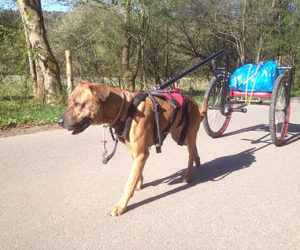 lifts the tip of the sulky off the harness.
lifts the tip of the sulky off the harness.
Walk behind the sulky while the dog pulls. Practice WALK, then WAIT. Once that is easy, then practice moving from WALK to TROT. Guide him with voice and reins. Many people add more weight each day for a week or so. Add more distance as well. Some dogs need to practice with the owner walking behind the sulk for weeks, even months. Other dogs are ready to pull the human quickly.
Some people skip the add-weight-each-day training because they have a helper. They sit in the seat on a level paved area and have a friend walk along near the dog’s head. Some people ride for short distances on level ground and get out of the sulky for up and down hills.
The important thing is to stop while the dog is wanting more. Stop before he gets tired. Train for a dog who is eager to pull.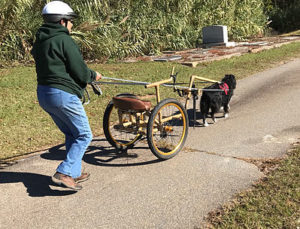
Gradually increase distance. A city block can be good the first few days. A mile is not far once the dog gets the hang of it. Work up to several miles. You can go more miles if you stop every few miles for a water break. I carry water bottles and folding water bowls in my fanny pack. One of my dogs guzzles down the water when we stop to cool down; another ignores the water.
RIDE THE SULKY
When you are able to sit in the sulky whenever you drive, every drive is a training drive. People ask “How long does it take to train a dog?” On the one hand with a dog who naturally pulls, like say a malamute, the initial ground training is short. Perhaps a week. On the other hand, that natural pulling dog will not be reliable with “On By” or “Wait”. My dogs wait while I run into the house for the forgotten water bottles or some other reason. Don’t skip the safety of ground training.
How long does it take to train a sulky dog? Several months? A year? One year I signed up to run a dog scooter race given by the Pennsylvania Sled Dog Club. My dogs had died by accident a few months before the race; long story. A month before the race, I adopted two shelter dogs each about a year old. We won the three mile race! (the section for amateurs – not the professionals!) It takes less time to train dogs to pull a scooter than to pull a sulky. Then I bought a collie puppy. Now he is two and a half years old. He is super reactive to cows and horses behind a fence. Two and a half years of training and he is not a safe reliable sulky dog. He will charge into the barbed wire fence to get at cows and horses. To be safe when driving with him, I harness him between my good working dogs and they control him when he sees cows and horses.
I think you can ride the sulky within a month. Every run I do is a training run.
PROBLEMS, SHORT CUTS
Come to the Chalo Sulky workshops offered two or three times a year.
Ask us to organize a workshop near you.
My dog won’t go in front of me.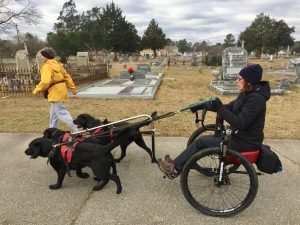
- Get a helper to walk beside the dog holding the leash. You walk behind the dog and the drag while he leads the dog. You give the commands from behind the drag.
- Hook your dog up with a trained dog. Let the trained dog teach your dog to work out in front.
- Use a TARGET.
No TARGET? Create one: a place where balls are thrown or sniffing is allowed or treats are given. Develop an awesome go-to place. Does the dog like a particular park? Park a block away and have him pull to the park with you running behind. Does the dog love to ride in the car? From a block away; have him pull to the car. Does the dog love your spouse? Station your spouse out in front and call the dog to him. - Use a RABBIT. Have the dog chase a spouse or friend on a bicycle. Join another dog driver and have your dog go along with that team.
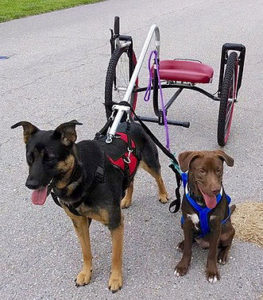
One of my dogs is tall and one is short.
Hitch one dog to the shaft. Let the other pull with a tugline. Neckline them together. In photo, puppy has no neckline, just a tugline.
Can I hitch four dogs?
Hitch two dogs to the tugline-dog hitch. Hitch the remaining two dogs to tuglines. They will run abreast of the two dogs on the shaft.
We recommend using the tug-line hitch when running more than two dogs. 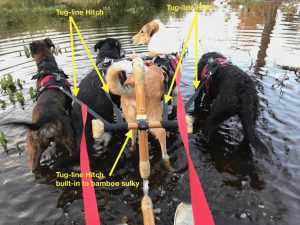
Training Videos
Mary Dick trains Quest and Frankie https://youtu.be/rMmoo7PIX0o
Train pup to pull- https://youtu.be/GNIiqwOPpgo
Training Aslan to pull- https://youtu.be/GAEUX0P5m6Q
Walk, Trot, Hike, Hike- https://youtu.be/y-6o7cB2_II
My Collie Pup learns to pull- https://youtu.be/Wymk7VTumOk
Wait, Wait, Backup- https://youtu.be/IDrF3fsJVhc
Your dog can pull- https://youtu.be/aZOxXZePtOU
Necklines & Sulky- https://youtu.be/lknn2EgbtIw
Workshop for dog driving- https://youtu.be/9Oo0NFX2Fg8
Dog driving workshop- https://youtu.be/uij5ldiY3Ic
Disassemble guide for Chalo Sulky- https://youtu.be/JsjuX6BZJjE
Back to Top
